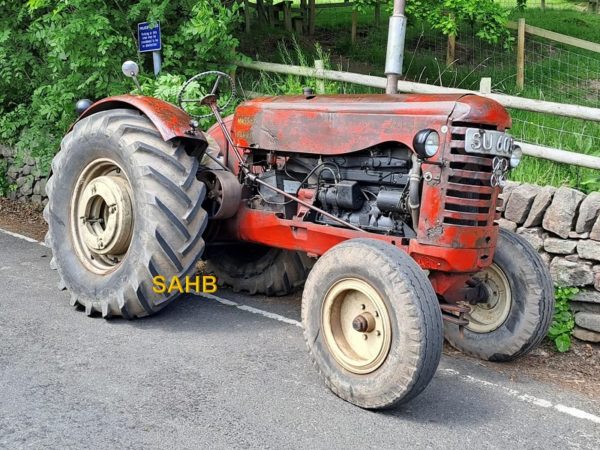
This well-used tractor plays an important part in the history of one of the world’s biggest tractor manufacturers: Massey Ferguson. It is impossible to confirm its exact age, but its 744D model number (invisible here but on the side panel just behind the radiator) gives it a manufacturing date between 1948 and 1958. It was probably built in Massey-Harris’s Kilmarnock factory; the 744PD was reputed to be built at the Manchester factory, but sources differ.
Essential equipment for any tractor is its PTO or Power Take-off – and this one has it in the form of a pulley, visible on the side of the tractor just below the steering wheel. It is clearly designed to drive equipment such as a threshing machine via a belt. Remarkably, the one thing that this tractor does NOT have is the nowadays almost universal three-point linkage invented by Northern Ireland-born Harry Ferguson. This had two dramatic advantages over the simple drawbar previously used to attach farm implements. The first was safety: implements were fixed firmly to the rear of the tractor and effectively became an extension of it. This stopped it from rearing up and overturning if it hit an obstruction in a field. The second was productivity: instead of having to detach the implement to move from field to field, the centre top link held the top of the implement and the two bottom links pivoted it up hydraulically away from the ground. So, for example, the tractor could move along the road to the next field, where the implement could be dropped again to start work.
Massey-Harris merged with Ferguson in 1953 to form Massey-Harris-Ferguson (renamed Massey Ferguson in 1958) and the three-point linkage was an optional fitting on the 744 from around the time of the merger.
The history of Massey-Harris started in 1847 in Ontario, Canada. Daniel Massey’s company built some of the world’s first mechanical threshers and, through extensive advertising, it became one of the most well-known brands in Canada.
In 1891, the Massey Manufacturing Co. merged with A. Harris, Son and Company to form Massey-Harris Limited, which became the largest agricultural equipment maker in the British Empire. Grain harvesting was revolutionized by Massey engineer Tom Carroll in 1938, with the world’s first affordable, mass produced, self-propelled combine.
As well as harvesters and ploughing equipment, tractors were a major Massey-Harris product. The 744 was powered in North America by Continental engines, but UK-built models were fitted with 6-cylinder 4.7-litre 46bhp Perkins diesels. The Perkins logo, four circles and a diamond, can be seen under the number plate in our Snapshot. In 1959, Massey Ferguson bought Perkins. Massey Ferguson survives and prospers to this day, with factories all over the world.







Leave a Comment